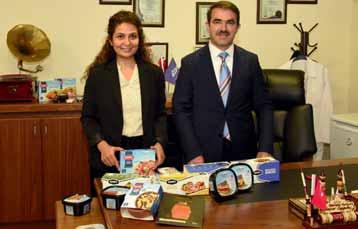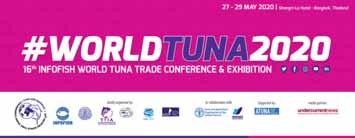
14 minute read
International Cold Water Prawn Forum, November 2019, Newfoundland and Labrador
by Eurofish
China, a huge and growing market for prawns
The International Cold Water Prawn Forum brings together companies, institutions, researchers, and others, with an interest in cold water prawns. Every two years the forum holds a cold water prawn conference to discuss the state of stocks, harvesting, processing, and markets. S hrimp can be either wildcaught or farmed and according to the FAO, while production from the wild has shown a faintly growing trend, since about 2003 volumes have been more or less stable, while farmed shrimp production over the same period has increased exponentially and is likely to continue increasing.
Advertisement
Developing countries increase their shrimp consumption Aquaculture offers several advantages, Felix Dent, FAO, told delegates. It is easier to control production levels, and there is greater potential for vertical integration. It is also easier to monitor size, colour, nutrition, and exposure to health hazards resulting in a highly uniform product. Most farmed shrimp production is in the developing world where it can contribute to food security through direct consumption and income generation. Globalisation and trade liberalisation has driven rapid growth in exports from developing countries to markets in the developed world but is now slowing due to a backlash against globalisation and more protectionist trade policies. Developing countries are increasingly finding national and regional markets for their products: developing countries’ share of shrimp imports, though still significantly lower than developed countries’, has been growing rapidly since 2008. Resources, markets, and the impact of climate change on cold water prawns were analysed at the recently concluded International Cold Water Prawn Forum conference held once every two years. world according to the OECDFAO Agricultural Outlook 2019- 2028 with China showing by far the most impressive growth. In Europe consumption is estimated to rise by between one and two kilos by 2028, while in China it is predicted to increase by five kg. Catering to this expected increase in demand for fish and seafood calls for strengthening governance, combating IUU fishing, and putting in place robust traceability and catch documentation systems, and encouraging the sustainable growth of the aquaculture industry. All the stakeholders from producers, to governments, consumers, regional fisheries management organisations and international organisations have a role to play. However, another factor, climate change, could complicate efforts to increase seafood production. Carbon dioxide emissions are heating and acidifying the oceans and even if emissions were to fall the heat and acidification will take a long time to reduce, said Eric Bjorkstedt, NOAA Fisheries. He pointed to changes in the Atlantic and Pacific oceans such as an intensification of coastal upwelling in the Pacific northeast and a warming and deoxygenation of water along the continental shelf and slope in the northwest Atlantic due to the weakening of the Labrador current. Warming, retreating sea ice, and altered currents can also be seen in the northeast Atlantic, while the north Pacific shows warmer conditions and reduced upwelling. These changes are likely to give rise to rapid shifts and unanticipated climate events such as marine heat waves, which will have an impact on marine life. Several factors can explain the growth in markets in developing countries including the emergence of a rapidly expanding middle class, particularly in China, increased urbanisation, greater prosperity, a lack of time to spend in the kitchen, growing awareness of health and lifestyle issues. These factors in turn have had an impact on distribution (more retail chain sales), product innovation (emphasis on processed foods, ready to cook, and ready to eat meals), and consumption (more out-of-home meals). Health awareness has also lead to greater consumer interest in species such as salmon and tuna which are perceived to have health benefits, and has contributed to the proliferation of standards and labels that certify all kinds of attributes that consumers claim to be concerned about. For example, between 2003 and 2018 the number of EU ecolabel licences went from 149 to 2,167, though they fell to 1,575 in 2019. Overall, data from the FAO show that per capita consumption of animal protein is increasing with seafood, pork, and poultry leading the way. Within the seafood category salmonids have a growing share of global import value while that of shrimp has fallen, but at 15 (2016) is still significantly higher than tuna (10), whitefish (10), or bivalves (3).
Climate change is likely to have unexpected impacts on resources Per capita fish consumption is projected to rise in all parts of the
Biomass may increase in some areas and decrease in others
Some of the effects of these changes on shrimp stocks were described in a presentation by Brian MacKenzie, DTU Aqua, who said that currently most stocks were at or above biomass limits, meaning that if exploitation continues at sustainable levels, then stocks can be expected to remain ecologically and economically viable in the short term. Over a longer timescale, however, climate change will influence shrimp fisheries as it alters the animal’s habitat. As water warms, for example, shrimp are likely to move north into cooler or deeper waters, though the rate of this move (how far, how fast) is uncertain. These developments will in turn have an impact on the biomass and fishery yields. How other species, in particular those that feed on, or provide feed for, shrimp, react to changes in the environment will also have a bearing on future shrimp abundance. The overall effect is likely to be that some areas will show increased productivity and fishable biomass, while others will show a decline. Knowledge is currently too fragmentary and limited to predict in detail when, where, and how fast shrimp biomass and distribution will change.
For shrimp catching and processing companies this is hardly reassuring. Uncertainty makes it difficult to plan especially if it involves decisions about highly capital-intensive investments, such as in vessels. Blaine Sullivan, Ocean Choice, a Canadian company fishing and processing several species at six plants in Newfoundland and Nova Scotia, spoke of a drop in shrimp landings from 106 thousand tonnes in 2006 to 45 thousand tonnes in 2018 caused largely by environmental factors. This decline makes it difficult to maintain harvesting and processing capacity and the company has had to adapt by converting one of its vessels from shrimp to groundfish and by processing more offshore industrial shrimp. The company has also taken several mitigation measures such as waste and emission reductions, maximising the use of resources, and investing in energy efficient solutions. Since climate change affects whole industries the company has partnered with other ocean-dependent firms to solve common challenges. Such initiatives, together with others to mitigate climate change, and investments in research and innovation are among Ocean Choice’s responses to the trends it is facing. Fishery Improvement Projects have been working with both inshore and offshore fisheries for the last years and progress has been significant. Outstanding issues include by-catch (inshore it is low, but offshore it is high), a management plan that is weak, and a lack of commitment from industry and the government. More and more processors are having their operations audited for compliance with international food quality standards like BRC and ISF, but progress on social certification has been slow. Catch quality needs to improve so that the product can convincingly carry a brand that positions Argentine red shrimp as a premium item. Renewing the fleet would contribute to better catch quality but is expensive and companies lack the necessary credit lines.
Shrimp processors in Argentina need to focus on value addition, certification
However, on another part of the American continent where another shrimp species is being fished, the picture looks different. Argentine red shrimp is the only crustacean fishery where captures and values have been increasing, reported Federico Angeleri, Grupo Varez. The shrimp is caught on the southern coast of Argentina by both artisanal and industrial fleets in inshore and offshore waters. The product is sold both fresh and frozen and exports are primarily to Spain and China. The fishery is managed by spatial and temporal closures (there are no quotas) and vessels need a valid permit and must meet legal requirements. Captures are monitored by observers and data on by-catch, size, maturity etc. reported to the authorities. Now, says Mr Angeleri, the fishery needs to evolve further in response to changes in the market by focusing more on sustainability, certification, added-value products, brand creation, and fleet renewal.
The Chinese market is huge but competitive and complex
Argentine red shrimp is just one of many species that feeds the vast Chinese market. With 1.4bn increasingly affluent consumers and a per capita consumption of seafood predicted to rise to 4 kg in 2022 from 3.8 kg in 2018, China sucks in huge and growing quantities of seafood from across the world. In terms of shrimp alone the country is a very important player as a producer, exporter, and importer. According to Darrel Roche, Whitecap International Seafood Exporters, improvements in the seafood cold chain enable consumers to order seafood online and have it delivered the same day or the next. Direct retail too has grown, and the ease with which consumers can get seafood, including shrimp, has increased their awareness making it popular also when dining out. For international seafood traders, other factors of interest, that influence the Chinese seafood market, include greater trust in products imported from the west and those that stem from the deep sea, and
a preference for seafood compared with pork due to the spread of swine influenza. The Chinese import market for shrimp is, at 8, the world’s third largest after the US and Japan and growth in import values have averaged 40 per year since 2014, while import volumes have grown on average by 35 a year since 2014. The main suppliers in 2018 were Ecuador, Argentina, and Thailand which accounted for 58 of Chinese imports by value. The imported products are overwhelmingly frozen shrimps and prawns which accounted for 75 of the value followed by frozen cold water shrimps and prawns at 16. The rest comprised fresh or chilled and prepared/preserved. Shrimp products launched on the Chinese market between 2014 and 2018 were promoted for their time saving attributes, suitability for microwaves, flexible packaging, and lack of additives. With Russian biomass increasing and strong growth in the Greenlandic resource, Mr Roche considered the Chinese market critical to increasing consumption of cold water prawns. His strategy to penetrating the Chinese market include focusing on e-commerce companies, traditional hypermarkets, large retailers, and the Horeca sector in cities approaching the top tier cities, as the former are growing rapidly. The existing four top tier cities (Beijing, Shanghai, Guangzhou, Wuhan), although massive consumer markets, are saturated, he said. In second tier cities, some 30 in number, the strategy is to target e-commerce companies, retailers and restaurants with whole cooked good value products. He also pointed to the importance of social media in marketing and promotion campaigns.
The presentations from the event are available at: https://icwpf.com/2019-icwpf-stjohns-nl-canada/presentationsfrom-icwpf19/
Sag˘diçlar Group — Five brothers create a leader in the Turkish fish trade
Expanding from fish wholesale and retail to new business ventures
Almost 40 years ago the five Sag˘ diç brothers started a small company trading locally sourced fish. Initially focusing on wholesale, the company subsequently opened a fresh fish section in a wholesale fish market and has since branched out in several different directions.
Founded in 1981, Sag˘diçlar’s trading business passed a milestone when it started exporting products to Germany in 2004. Then later the company opened its own supermarket chain “Ideal”, which now operates in two locations. In 2006 a chain of fish restaurants, “Balik Ye”, was established that exclusively serve fish from the company’s production. In 2011 the company expanded into software development, as the need to improve the systems to manage their different activities grew. The company “Save As” today accommodates about 70 of the group’s IT needs.
Opportunities in HoReCa
Some years later Sag˘diçlar saw an opportunity in supplying Istanbul’s HoReCa segment with high-margin, value-added products. To produce these the group opened its own 1,200m 2 production facility in 2016. Here around 600 tonnes of seafood are processed into added-value products including fish soups, smoked fish, fishmeat balls and fish burgers, seafood salads, marinated fish products, and other varieties of frozen and fresh fish products.
In 2018 the group established the Bando Food brand with packaging depicting seafood playing musical instruments as if in a band. That year also saw the launch of its e-commerce business, for which the software company developed a mobile application for both Apple and Android phones along with the www.balikye.com online sales channel. Consumers can order multiple of kinds of seafood to be delivered to their homes. The e-commerce business has also been extended to their Ideal supermarket chain www. ideal.com.tr so that daily groceries can be purchased in addition to the fish.

Ms Göknur Gezköy, Export and Import Manager, stands with Mr Veysel Sagdic, Chairman of the Board.
Exclusive distributorships
Sag˘diçlar is the exclusive authorised Turkish distributor of Pinar Balik, one of Turkey’s largest producers of seabass and sea bream. It also has an exclusive trade agreement with Mowi, a Norwegian salmon producer, covering the Marmara region. Last year the company started rearing rainbow trout and seabass at a farm in Artvin, in eastern Turkey, close to the Black Sea.
The fisheries and seafood part of the group today consists of the processing facility, the fish farm for seabass and rainbow trout, and three sales outlets at the Istanbul wholesale fish market, the Izmir main fish market, and in Kavacik/Istanbul. Fresh products are sold in over 40 locations with shop in shops in domestic and international supermarket chains like Migros, carrefour, Macrocenter and etc. Internationally the company exports its range of
Sag˘diçlar Balikçilik
Madenler Mah. Alemda ˘g Cad. Arafat Sk No:2 Ümraniye Istanbul Turkey Tel:+90 216 364 24 37 info@sagdiclar.com www.sagdiclar.com
Chairman of the Board: Mr Veysel Sa ˘gdiç Export and Import Manager: Ms Göknur Gezköy products to Europe, the Middle East, Asia, and the North America, markets. The growing success of Sagdiclar’s symphony of products has allowed the company to support the local community.
Turnover 2019: EUR 25 million Employees: 310 Activities: Wholesale and retail trade, supermarkets, software development, processing, and aquaculture. Markets: Turkey, Germany, Kuwait, Dubai, Hong Kong, Russia, Israel, Saudi Arabia, Holland, Bulgaria, Canada and USA USA.
News
Romania to chair EUROFISH Governing Council
Th e 19 th session of the EUROFISH Governing Council will be held on 6 and 7 February 2020. Th is is the annual meeting that brings together representatives from the organisation’s member countries (Albania, Croatia, Den mark, Estonia, Hungary, Italy, Latvia, Lithuania, Norway, Poland, Romania, Spain, and Turkey), observer countries, and institutions (FAO, Baltic Sea Advisory Council, GFCM, Nordic Council of Ministers) to review the activities conducted by the organisation in 2019 and to approve the work programme proposed for 2020. Th is year, chairmanship of the Governing Council, which rotates between the member countries every two years, will move from The EUROFISH Governing Council on 6 and 7 February will gather representatives from the organisation’s member countries, observer countries, and institutions.

Italy to Romania. Th e chairperson will be assisted by the vice chairperson (Estonia) and the rapporteur (Poland). Th e Governing Council will also discuss fi nancial and budgetary issues. Interspersed with the administrative matters will be presentations on recent trade agreements and market access by the FAO expert, on the implementation of a traceability system in Latvia, and on Croatian experiences with the digitalisation of systems for fi sheries control and traceability.
TUNA 2020 promises to live up to its billing as world’s leading tuna event
Tuna is among the world’s most highly traded fi sh with over 100 countries importing (and some 75 exporting) at least 1,000 tonnes. Th e term tuna refers to several diff erent species, of which the most important (in volumes) are skipjack, yellowfi n, bigeye, albacore, and bluefi n. Landings of tuna are however dominated by the fi rst two which together account for over four fi fths of the total. Th e main tuna fi shing grounds are in the Pacifi c, Atlantic, and Indian Oceans, of which the Western Central Pacifi c alone is responsible for half the total landings and almost 65 of the landings of skipjack, the main species used by the tuna canning industry. Tuna fi sheries are managed by regional fi sheries management organisations which study the status of stocks and provide advice regarding quotas to their members.

Th e tuna is big, complex and globe-spanning with thousands of stakeholders. At TUNA 2020, the 16th INFOFISH World Tuna Trade Conference & Exhibition, all the issues surrounding the tuna industry such as stock status, fi shing gear, sustainability, markets, products, processing, certifi cation, technology, and trade, to name a few, will be addressed by experts from around the world. Held every two years, the event is organized by INFOFISH in collaboration with the Department of Fisheries (DOF), Th ailand, Th ai Tuna Industry Association (TTIA), FAOGlobefi sh, Indian Ocean Tuna Commission (IOTC), Inter-American Tropical Tuna Commission (IATTC) and Western and Central Pacifi c Fisheries Commission (WCPFC) and is the leading tuna conference in the world. In 2018 almost 600 delegates from close to 70 countries attended, representing private industry, government authorities, NGOs, research institutions, and others, and this year the number is expected to be even higher. Th e conference and exhibition will be held in the Shangri La hotel in Bangkok on 27-29 May 2020. For more information visit http://tuna.infofi sh.org/ or write to info@infofi sh.org.










